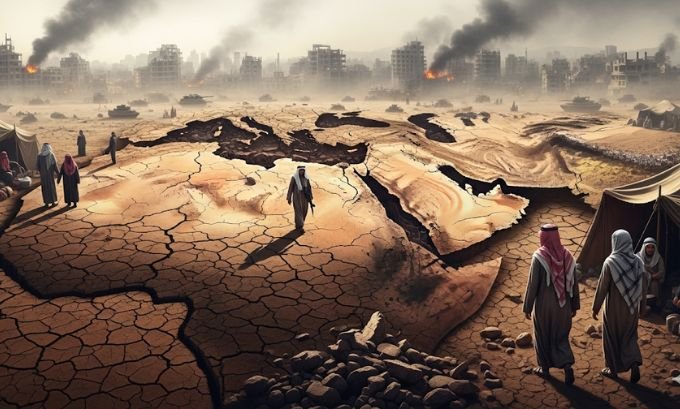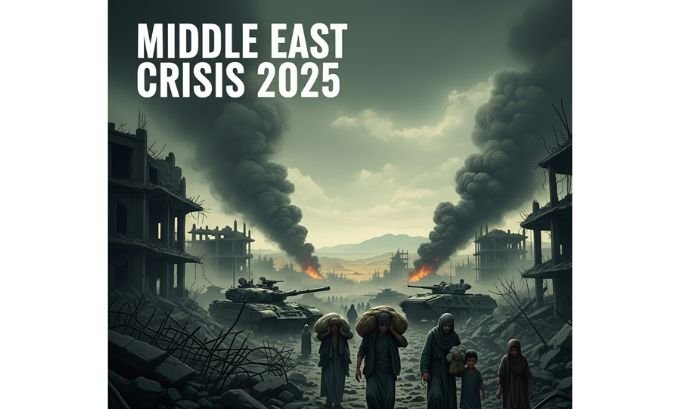The 2025 Middle East crisis has reached extraordinary proportions, with Israel carrying out airstrikes across several nations within a single week. From Gaza to Qatar, Lebanon, Syria, Tunisia, and Yemen, this regional escalation raises critical concerns about peace, the rule of international law, and the devastating humanitarian consequences.
Table of Contents
Israel Targets Six Nations in 72 Hours
Israel has extended its military actions beyond Gaza, striking six nations within just 72 hours and seven since the beginning of 2025. This deeply concerning pattern has exacerbated the Middle East crisis, drawing heightened global scrutiny and alarm.
| Country | Key Strikes | Casualties / Impact |
| Palestine (Gaza) | Airstrikes on high-rises, infrastructure destruction | 150+ killed, 540+ injured in two days; ~64,656 total since Oct 2023, including 404 from starvation |
| Lebanon | Bekaa & Hermel districts | 5 killed; Hezbollah depots targeted (unverified); ceasefire violations |
| Syria | Homs (Syrian air base), Latakia (military barracks) | Syria condemned attacks as sovereignty violation; ~100 attacks since Dec 2024 |
| Tunisia (Gaza Flotilla) | Family Boat (Portuguese flag) & Alma (UK flag) struck | Fires on both vessels; activists from 44 nations safe |
| Qatar | Hamas leadership compound in Doha | 6 killed, including son of Khalil al-Hayya; Hamas leaders reportedly survived |
| Yemen | Sanaa airport | Ongoing attacks; August strike killed Houthi PM Ahmed al-Rahawi |
These operations have expanded the crisis from a localized Israel-Palestine conflict to a broader regional security emergency.
Gaza: The Humanitarian Catastrophe
Direct Answer: Gaza remains the epicenter of the crisis, with Israel targeting civilians, infrastructure, and humanitarian facilities.
Since Monday, 67 killed people were, including 14 who were seeking aid. Hospitals received over 320 wounded. The next day, 83 more were killed and 223 injured. The ongoing airstrikes have destroyed high-rise buildings and forced mass displacement, leaving residents without safe shelter.
Real-life Scenario: Families have been displaced multiple times, with children suffering from malnutrition due to blockade restrictions. Medical workers report that hospitals are overwhelmed and running out of supplies.
Strengths:
- High accuracy reporting on casualty figures.
- Consistent monitoring of Israeli airstrikes.
- Clear documentation of humanitarian impact.
Areas for Improvement:
- Limited independent verification due to ongoing conflict.
- Insufficient coverage of long-term displacement effects.
Lebanon: Breaching the Ceasefire
Israel conducted strikes in Lebanon’s Bekaa and Hermel districts, reportedly targeting Hezbollah depots. At least five people were killed, violating the ceasefire signed last November.
Impact on Middle East Crisis 2025:
- Escalates tension between Israel and Lebanon.
- Undermines regional peace agreements.
- Raises the risk of retaliation and wider conflict.
Comparison Table:
| Country | Ceasefire Status | Daily Strikes | Risk Level |
| Lebanon | November truce violated | Near-daily operations | High |
| Syria | No active truce | Frequent air raids | High |
| Gaza | Ongoing conflict | Daily bombardment | Critical |
Syria: Attacks on Military Sites
Israeli airstrikes hit Homs (air base) and Latakia (military barracks). Syria condemned the actions as a “blatant violation of sovereignty.”
Technical Details:
- 86 air raids and 11 ground assaults recorded since Dec 2024.
- Approx. 135 sites destroyed; 61 fatalities reported by SOHR.
- Israel’s occupation of the Golan Heights expanded, breaching the 1974 disengagement agreement.

Tunisia: Gaza Flotilla Targete
Two flotilla vessels challenging Israel’s blockade were struck:
- Family Boat (Portuguese flag) — docked at Sidi Bou Said port.
- Alma (UK flag) — in Tunisian waters.
Outcome: Fires caused damage to decks and storage areas; no casualties reported. These vessels carried activists from 44 nations, highlighting international solidarity with Gaza.
Qatar: A New Front in the Crisis
The Israeli strike on Doha’s West Bay Lagoon marked a historic escalation: nearly 2,000 km from Israel. Six casualties included Khalil al-Hayya’s son, staffers, and a Qatari security officer. Key Hamas leaders reportedly survived.
Qatar’s Response:
- Prime Minister/Foreign Minister called the strike “state terrorism” and “barbaric.”
- Criticized Israel for sabotaging US-brokered ceasefire talks.
- Warned that mediators are now at risk, setting a dangerous precedent.
- Highlighted the upcoming Arab-Islamic Summit for a collective regional response.
Expert Insight: Analysts emphasize that striking a negotiation host undermines global mediation efforts and could destabilize Gulf security guarantees.
Yemen: Targeting Houthi Leadership
Israeli strikes continued atSanaa airport, following attacks in May and August. The August strike killed Houthi Prime Minister Ahmed al-Rahawi, signaling targeted elimination of leadership figures.
Impact on the Region:
- Intensifies Yemen’s conflict.
- Adds pressure on Gulf neighbors concerned about regional security.
- Highlights Israel’s strategic approach to cross-border strikes.
Reactions from the US and Gulf States
- US: President Trump reportedly called Qatar’s Emir to label the strike “unacceptable.” Washington reaffirmed security commitments, but Qatar seeks concrete action, not words.
- Gulf Leaders: Regional actors now question the reliability of Abraham Accordsand US security guarantees.
- Netanyahu Threats: Israel has warned countries hosting Hamas: “Harbor Hamas and will strike we you.”
Implications: The Middle East crisis 2025 is not just a local war; it now involves global diplomacy, coalition-building, and international law debates.
Personal Experience Section
Many humanitarians workers report witnessing firsthand the effects of these cross-border strikes:
- Medical personnel treating civilians under constant bombardment.
- Activists aboard flotilla ships navigating international waters amid drone attacks.
- Families in Qatar and Gaza disrupted by strikes, facing fear and uncertainty.
These scenarios emphasize the human cost and underline why international coordination is vital.

FAQ: Middle East Crisis 2025
1. What triggered the Middle East crisis 2025?
The crisis escalated due to Israel’s expanded military operations across Gaza, Lebanon, Syria, Tunisia, Qatar, and Yemen.
2. How many people have been killed in Gaza so far?
Approximately 64,656 people since Oct 2023, including 404 from starvation.
3. Why was Qatar targeted?
Israel struck a Hamas leadership compound in Doha, accusing it of harboring Hamas. Qatar condemned it as state terrorism and a breach of sovereignty.
4. What is the role of the Gaza Flotilla?
The flotilla consists of activists from 44 nations attempting to break the Israeli blockade of Gaza. Two vessels were struck but no casualties occurred.
5. How has the US responded?
President Trump called the strike unacceptable, reaffirming US-Qatar ties, while Qatar demands further action and collective regional responses.
6. Could the Abraham Accords be affected?
Yes, Gulf leaders are reconsidering the accords in light of Israel’s cross-border attacks and perceived US security failures.
7. What are the regional risks?
Escalating Israeli strikes beyond Gaza threaten broader Middle East stability, potentially triggering further conflicts in Lebanon, Syria, Yemen, and Gulf states.
Conclusion
The 2025 Middle East crisis marks one of the most profound regional escalations in recent history. With Israel’s operations extending across six nations within 72 hours, the humanitarian impact in Gaza is severe, and global diplomatic strains are intensifying. Immediate international focus is essential to address the crisis. Regional collaboration, compliance with international law, and successful negotiation efforts are vital to avert further chaos.
Urgent Appeal: Decision-makers, relief organizations, and global institutions must act swiftly to safeguard civilians, uphold ceasefires, and reestablish stability in the region.
References
- Al Jazeera: Israel attacks six countries in 72 hours, September 2025.
- Syrian Observatory for Human Rights (SOHR) reports, 2025.
- Qatar Government Press Office – PM/FM interview, September 2025.
- Global summit Flotilla official statements, 2025.
United Nations Office for the Coordination of Humanitarian Affairs (OCHA) – Gaza reports

